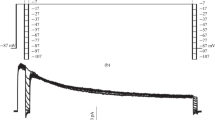Abstract
The activation of calcium-dependent outward potassium current [IK(Ca)] by shortlasting Ca2+ inward currents was studied. These Ca2+ currents were produced either by small depolarizing pulses preceding the larger depolarizations or by interposed repolarizations (I.R.s) starting from depolarized membrane potentials. IK(Ca) then develops with a potential-invariant time course (half time 6–12 ms) and the normally bell-shaped isochronal IK(Ca)/V curve, measured at between 30 and 300 ms, is straightened. However, these Ca2+-injecting pulses, of any amplitude and duration, do not increase the steady-state conductance to values beyond those measured with single step depolarizations to lower potentials. varied in length, activation of IK(Ca) increased linearly with the during depolarization to near the supposed calcium equilibrium potential with no further Ca2+ influx. When I.R.s are varied in length, activation of I(Ca) increases linearly with the amount of Ca2+ current. Fading of activation during I.R. follows a time course nearly ten times slower than activation and is not expressed in tail currents. The time course of IK(Ca) is described by a function defined only by voltage parameters of activation combined with a minimum activation time constant which is similar to that found in tail currents. Peak location and general form of the IK(Ca)/V relationship for times up to several hundred milliseconds are well predicted without the necessity to explicitly account for actual calcium entry.
Similar content being viewed by others
References
Akaike N, Lee KS, Brown AM (1978) The calcium current in Helix neurons. J Gen Physiol 71:509–531
Connor JA (1979) Calcium current in molluscan neurones. Measurement under conditions which maximize its visibility. J Physiol (Lond) 286:41–60
Goldman DE (1943) Potential impedance and rectification in membranes. J Gen Physiol 27:37–60
Gorman HLF, Thomas MV (1980) Intracellular calcium accumulation during depolarization in a molluscan neurone. J Physiol (Lond) 308:259–285
Gorman HLF, Thomas MV (1980) Potassium conductance and internal calcium accumulation in a molluscan neurone. J Physiol (Lond) 308:287–313
Heyer CB, Lux HD (1976) Properties of a facilitating calcium current in pace-maker neurones of the snail, Helix pomatia. J Physiol (Lond) 262:319–348
Hodgkin AL, Huxley AF (1952) A quantitative description of membrane current and its application to conduction and excitation in nerve. J Physiol 117:500–544
Hodgkin AL, Katz B (1949) The effect of sodium ions on the electrical activity of the giant axon of the squid. J Physiol (Lond) 108:37–77
Hofmeier G, Lux HD (1978) Inversely related behaviour of potassium and calcium permeability during activation of calcium-dependent outward currents in voltage-clamped snail neurones. J Physiol (Lond) 287:28–29P
Hofmeier G, Lux HD (1981) The time courses of intracellular free calcium and related electrical effects after injection of CaCl2 into neurones of the snail,Helix pomatia. Pflügers Arch 391:242–251
Kostyuk PG, Krishtal OA (1977) Separation of sodium and calcium currents in the somatic membrane of mollusc neurones. J Physiol (Lond) 270:545–568
Kostyuk PG, Krishtal OA, Pidoplichko VI (1981) Calcium inward current and related charge movements in the membrane of snail neurones. J Physiol (Lond) 310:403–421
Lux HD, Heyer CB (1979) A new electrogenic calcium-potassium system. In: Schmitt FO, Worden FG (eds) The neurosciences. 4th study program. The MIT Press, Cambridge, MA, USA
Lux HD, Hofmeier G (1982) Properties of a calcium- and voltageactivated potassium current inHelix pomatia neurons. Pflügers Arch 394:61–69
Lux HD, Neher E, Marty A (1981) Single channel activity associated with the calcium dependent outward current inHelix pomatia. Pflügers Arch 389:293–295
Meech RW (1974) The sensitivity of Helix aspersa neurones to injected calcium ions. J Physiol (Lond) 237:259–277
Neher E, Lux HD (1969) Voltage clamp onHelix pomatia neuronal membrane; current measurements over a limited area of the soma surface. Pflügers Arch 311:272–277
Neher E, Lux HD (1973) Rapid changes of potassium concentration at the outer surface of exposed single neurons during membrane current flow. J Gen Physiol 61:385–399
Woolum John C, Gorman ALF (1981) Time dependence of the calcium-activated potassium current. Biophys J 36:297–302
Author information
Authors and Affiliations
Rights and permissions
About this article
Cite this article
Lux, H.D., Hofmeier, G. Activation characteristics of the calcium-dependent outward potassium current in Helix. Pflugers Arch. 394, 70–77 (1982). https://doi.org/10.1007/BF01108310
Received:
Accepted:
Issue Date:
DOI: https://doi.org/10.1007/BF01108310




